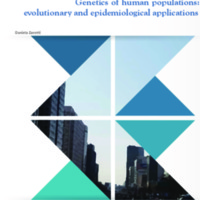Genetics of human populations: evolutionary
and epidemiological applications
Dublin Core
Description
The present thesis deals with a deep analysis of the genetic structure of extant human worldwide populations, with a special focus on the Mediterranean. Different genetic markers, 18 Alu insertions and 367 single nucleotide polymorphisms (SNPs), were analysed for the first time in general populations and Bedouins from Jordan. The same SNPs were also genotyped in a consistent set of samples from the Mediterranean Basin. Specifically, Alu markers were used to assess the genetic diversity within Jordan and to define the relationships across present-day Middle Eastern, North African, and European populations. While SNPs located in the top coronary artery disease (CAD) risk regions (1p13, 1q41, 9p21, and 10q11) were used to explore the genetic variation and the LD patterns across 19 populations from Europe, Middle East and North Africa, together with Asian and African samples from the 1000 Genomes Project. Furthermore, Tunisian and Moroccan case-control samples were used to test for the first time the applicability of European GWAS results in these four genomic regions to North African populations. Finally, simulated genomic data were used to evaluate the consistency of association results across European, Asian and Sub-Saharan African case-control samples. Neutral and CAD risk markers pointed out a low but significant geographic structure in the Mediterranean area. As a particular case in the Mediterranean context, Bedouins and general population from Jordan showed statistical differences (p=0.038). The genetic heterogeneity detected is likely related to the fact that urban areas have been subject to several external influences but Bedouins have preserved their own genetic background because of their nomadic and isolated lifestyle. The general patterns of genetic variation observed in the four CAD risk regions analysed are in agreement with the genetic structure generated by demographic processes. Despite this fact, the present work also identified potential signals of positive and balancing selection in some specific risk markers and haplotypes. Actually, potential signatures of positive selection in the 9p21 region and of balancing selection in 9p21 and 10q11 have been observed. The regions under positive or balancing selection are shared across continents but the specific markers under selection are, in some cases, continent-specific. Results from the association study in North Africa revealed significant association signals in the four genomic regions analysed in Moroccan and Tunisian samples confirming the trans-ethnic importance of these genomic regions for the risk of CAD. However, in the meta-analyses performed with the North African case-control samples, only the 9p21 and 10q11 regions showed association signals and none of the North African risk SNPs was associated with CAD in Europe. These arguments suggest the existence of continent-specific CAD risk variants in these chromosomal regions. Significant differences in the LD and in the haplotype patterns confirm the heterogeneity in the genomic structure between North Africans and Europeans. In addition, differences in the LD structure persist even across Europeans, North Africans, Asians, and Sub-Saharan Africans. Finally, the simulation study highlighted an overall consistency in effect direction across populations of different ancestry, specially between Europeans and Asians. Because simulations assumed no actual differences in genetic effect size between populations and because the rate of between-population effect size differences generated by our study was considerably lower than the rate reported from empirical studies using real data, our study supports the existence of real differences in the genetic risk architecture of complex traits between populations. In general, this study confirmed that a substantial fraction of association signals are shared across people of different ancestries. However, some discrepancies in the effect size across populations highlighted the importance of accounting for population structure in association studies.
Creator
Publisher
Contributor
Cut Rita Zahara
Rights
Creative Commons
Type
Files
Collection
Citation
Daniela Zanetti , “Genetics of human populations: evolutionary
and epidemiological applications ,” Open Educational Resources (OER) , accessed January 15, 2026, http://oer.uinsyahada.ac.id/items/show/575.


